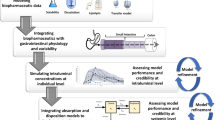Abstract
Purpose. The present investigation retrospectively evaluates the use of human hepatocytes to classify compounds into low, intermediate or high hepatic extraction ratio in man.
Methods. A simple approach was used to correlate the in vivo hepatic extraction ratio of a number of compounds in man (literature and in-house data) with the corresponding in vitro clearance which was determined in human hepatocytes. The present approach assumes that, for compounds eliminated mainly through liver metabolism, intrinsic clearance is the major determinant for their in vivo hepatic extraction ratio and subsequently their bioavailability in man. The test compounds were selected to represent a broad range of extraction ratios and a variety of metabolic pathways.
Results. The present data show that in vitro clearances in human hepatocytes are predictive for the hepatic extraction ratios in vivo in man. Most of the test compounds (n = 19) were successfully classified based upon human hepatocyte data into low, intermediate or high hepatic extraction compounds, i.e. compounds with potential for high, intermediate or low bioavailabilities in humans.
Conclusions. The present approach, validated so far with 19 test compounds, appears to be a valuable tool to screen for compounds with respect to liver first-pass metabolism at an early phase of drug discovery.
Similar content being viewed by others
REFERENCES
G. Desousa, N. Florence, B. Valles, P. Coassolo, and R. Rahmani. Cell Biol. Toxicol. 11:147–153 (1995).
J. B. Houston. Biochem. Pharmacol. 47:1469–1479 (1994).
K. Zomorodi, D. J. Carlile, and J. B. Houston. Xenobiotica 25:907–916 (1995).
K. A. Hayes, B. Brennan, R. Chenery, and J. B. Houston. Drug Metab. Dispos. 23:349–353 (1995).
B. A. Hoener. Biopharm. Drug Dispos. 15:295–304 (1994).
T. Seddon, I. Michelle, and R. J. Chenery. Biochem. Pharmacol. 38:1657–1665 (1989).
G. Fabre, R. Rahmani, M. Placidi, J. Combalbert, J. Covo, J. P. Cano, C. Coulange, M. Ducros, and M. Rampal. Biochem. Pharmacol. 37:4389–4397 (1988).
M. Rowland, and T. Tozer. Lea and Febiger, Philadelphia, London, (1989).
P. Skett, C. Tyson, A. Guillouzo, and P. Maier. Biochem. Pharmacol. 50:280–5 (1995).
M. Spatzenegger, and W. Jaeger. Drug Metab. Rev. 27:397–417 (1995).
S. Kawasaki, Y. Sugiyama, T. Iga, M. Hanano, T. Beppu, M. Sugiura, K. Sanjo, and Y. Idezuki. Clin. Pharmacol. Ther. 44:217–224 (1988).
M. Bonati, R. Latini, G. Tognoni, J. F. Young, and S. Garattini. Drug Metab. Rev. 15:1355–83 (1984).
U. Klotz, K. H. Antonin, and P. R. Bieck. J. Pharmacol. Exp. Ther. 199:67–73 (1976).
P. Hoglund, and L. G. Nilsson. Ther. Drug Monit. 10:401–409 (1988).
H. Boxenbaum. J. Pharmacokinet. Biopharm. 10:411–426 (1982).
H. Allonen, G. Ziegler, and U. Klotz. Clin. Pharmacol. Ther. 30:653–661 (1981).
M. T. Smith, M. J. Eadie, and T. O. Brophy. Eur. J. Clin. Pharmacol. 19:271–278 (1981).
P. Heizmann, M. Eckert, and W. H. Ziegler. Br. J. Clin. Pharmacol. 16:43S–49S (1983).
J. P. Labaune. Masson, Paris, (1991).
J. Sonne, S. Loft, M. Dossing, A. Vollmer-Larsen, K. L. Olesen, M. Victor, F. Andreasen, and P. B. Andreasen. Eur. J. Clin. Pharmacol. 35:385–389 (1988).
L. S. Olanoff, T. Walle, K. Walle, T. D. Cowart, and T. E. Gaffney. Clin. Pharmacol. Ther. 35:755–761 (1984).
G. A. Rongen, J. W. M. Lenders, P. Smits, and T. Thien. Clin. Pharmacokinet. 29:6–14 (1995).
F. Gaspari, and M. Bonati. Drug Metab. Rev. 22:179–207 (1990).
N. H. G. Holford. Clin. Pharmacokinet. 11:483–504 (1986).
Rights and permissions
About this article
Cite this article
Lavé, T., Dupin, S., Schmitt, C. et al. The Use of Human Hepatocytes to Select Compounds Based on Their Expected Hepatic Extraction Ratios in Humans. Pharm Res 14, 152–155 (1997). https://doi.org/10.1023/A:1012036324237
Issue Date:
DOI: https://doi.org/10.1023/A:1012036324237




